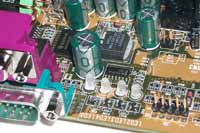Microstar BXMaster i440BX Slot-1 ATX
by Mike Andrawes on January 29, 2000 2:29 AM EST- Posted in
- Motherboards
The other really unique feature of the BXMaster is MSI's new Diagnostic LED technology, called D-LED for short. The D-LED consists of 4 LED's at the back of the motherboard, next to the serial/parallel ports. As the system boots, you'll notice the LED's blink green and red in a variety of patterns as different components are initialized. If everything is successful, all LED's will finally illuminate green. If a problem occurs, the pattern on the LED's can be used to help troubleshoot. A convenient sticker, which should be placed inside the computer, is included in the box that lists all possible problems that can be displayed by D-LED. Overall, D-LED could be one of the most useful features for troubleshooting a system. A 5th LED indicates power to the DIMM slots so you don't accidentally unplug your memory while the system is in suspend mode.
The ATX 2.01 specification is closely followed for the most part. All HDD/FDD connectors are placed in front of the DIMM slots. The ATX power connector is not so wisely placed, located behind the Slot-1 connector, and requires cables to run over the CPU and memory cluttering things up and impeding air flow. A PC speaker is also integrated on the motherboard.
Twelve 1000uF and one 1500uF capacitors are located just behind the Slot-1 connector, while four more 1000uF are flush against the DIMM slots. This all helps keep the BXMaster quite stable, although not quite as rock solid as the best boards to come through the AnandTech labs, such as the AOpen AX6BC Pro II Millennium Edition.
One of the biggest additions for most i440BX boards of this generation is improved overclocking support. Jumperless CPU setups are almost ubiquitous these days, but MSI has gone the extra step to include a plethora of FSB settings and CPU core voltage adjustment. The BXMaster's BIOS core is still based on the old AWARD 4.51PG, but features MSI's CPU Plug & Play III Jumperless CPU configuration utility. FSB options include 66 / 75 / 78 / 81 / 83 / 90 / 95 / 100 / 105 / 110 / 112 / 115 / 117 / 120 / 122 / 124 / 126 / 133 / 135 / 138 / 140 / 142 / 144 / 150 / 155, which puts it ahead of virtually everything on the market, surpassed primarily by the ABIT BF6 and BE6-II with their SoftMenu III support. The PCI speed is reported next to the FSB setting, which should help you keep things as close to the 33 MHz PCI spec as possible. PCI ratios of 1:4, 1:3, and 1:2 are automatically set based on FSB speed. Like all i440BX boards, the AGP ratio is either 2:3 or 1:1, which makes pushing much beyond 124 MHz with an AGP card a tricky proposition.
Vcore settings range from 1.30 - 2.10V, in 0.05V increments and then from 2.1V to 3.5V in 0.1V steps. Only a limited range of voltages is displayed based on the CPU used - for example, our testbed Pentium III 550E had a default voltage of 1.6V and could be set to anything between 1.30V and 2.00V. An additional feature the MSI has implemented is support for chipset voltage, which ranges from 3.3V to 3.6V in 0.1V steps. While we've yet to need such features in the AnandTech labs as of yet, it might come in handy at a later date.
The rest of the BIOS is pretty much the standard Award 4.51PG setup. Power management consists of pretty much the standard stuff these days. Wake on LAN and wake on modem ring headers are available to allow the system to power on in the presence of network activity or incoming call. The BIOS can be set to turn on the system at a specific time. The CPU fan can be shut off when the system suspends to quiet things down a bit. Full ACPI support is included for additional power management options under an ACPI compliant OS, such as Windows 98 or 2000.
One feature that is included, but is still missing on some motherboards, is the ability to configure what the system will do when AC power is restored after a power outage. The system can either remain off, turn on, or resume last power state when power is restored. This is a feature often overlooked since ATX and soft power became available, but is critical for anyone using their system where it must be on 24/7 or as close as possible. It also allows for users to shut the system on and off from a surge protector.
Hardware monitoring is provided courtesy of the classic Winbond 83782D hardware monitoring chip. That means 9 voltages, 3 temperatures, and 3 fan speeds are monitored. Unfortunately, despite support in the 83782D for reading CPU temperature from the on-die thermal diode, MSI is still using a thermistor mounted right in front of the Slot-1 connector. A header for an additional external thermistor is located just behind the Slot-1 connector. Two fan headers are right next to the CPU, while the third is at the front of the board in front of the expansion slots. At boot, all monitored settings that are enabled in the BIOS are displayed. If the high or low limit is surpassed, a warning will come through the PC speaker and be displayed on screen.











0 Comments
View All Comments